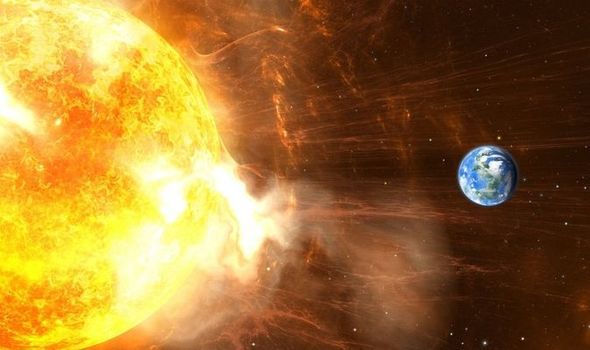
Space weather forecasters have warned that a large solar flare is “heading to Earth” today sparking concerns of satellite disruptions and power outages for billions.
Forecasters at the Space Weather Prediction Center (SWPC), which is a unit of the US Department of Commerce under NOAA, have issued a G2 geomagnetic storm warning for October 11.

The Express reports: Solar storms are rated on a scale from G1 to G5 – with one being the weakest and five having the most potential for damage. But even a G1 stomp’s can create issues for billions, as experts expect power grid fluctuations and minor impacts on satellite operations.
In a statement SWPC said: “Induced currents / power grid fluctuations can occur.
“High-latitude power systems may experience voltage alarms.
“Spacecraft – satellite orientation irregularities may occur, increased drag on low Earth-orbit satellites is possible.”
The Sun is the primary cause of space weather.
At times, the Sun can be thought of as going through a “stormy” period where its surface is more active than normal.
When this happens, it can send streams of energised particles out in all directions, which can be observed through the Northern Lights and the Southern Lights.
While these solar events can help illuminate the sky with stunning aurora, they can also do considerable harm to electronics, electrical grids, and satellite and radio communications.
Cyber security expert Chris Vickery wrote on Twitter: “Heads-up. Big solar flare observed and headed for Earth.
“Trajectory is going to be a direct hit. Expect low-level geomagnetic disruption.”
He added that the estimated time of impact was between 6am and 6pm today.
Spaceweather.com is reporting that a “halo” coronal mass ejection (CME)” has been spotted.
They explained: “This is called a ‘halo CME’ because CMEs heading directly for Earth seem to form a 360-degree halo around the Sun.
“CMEs heading directly away from Earth can form a halo, too, but that’s another story.”
“So far this year, dozens of CMEs have missed Earth. Many of them were near misses, provoking no more than minor geomagnetic unrest as they passed by.
“This time, however, the Sun is shooting straight.”
Related posts:
Views: 0
 RSS Feed
RSS Feed















 October 11th, 2021
October 11th, 2021  Awake Goy
Awake Goy 
 Posted in
Posted in  Tags:
Tags: 
















